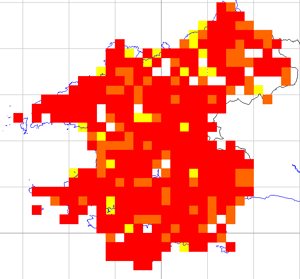Breeding summer visitor and passage migrant
A common summer visitor to Mathew (1894), arriving in April and departing by early October. Lockley et al. (1949) agreed that the Swallow was a common summer visitor and added that it was abundant on passage. Today they breed commonly throughout the county (see map). At an average density of 20 pairs per tetrad there must be at least 8,500 pairs. Most nests are situated in farm buildings but other inhabited and derelict buildings are also utilised. They regularly breed in a sea cave at Martin's Haven, providing endless entertainment to folk waiting for the Skomer boat. A pair bred underground in a heating duct at Stackpole in 1987.
The first Swallows usually arrive in Pembrokeshire in the last week of March, occasionally from the 8 March onwards. Spring migrants are sometimes seen flying south again, a ringing recovery of one marked at Skokholm and recovered in Cornwall three days later suggesting that they may sometimes overshoot their destination or can retreat if they outstrip favourable weather conditions. They pass northwards across the county throughout April and May and a few can still be seen passing until early July. Many pause to hawk for food, freshwater proving a particularly attractive diversion. Bad weather, particularly drizzle, can cause a temporary halt and hundreds of Swallows will gather at places such as Pembroke Mill Ponds and Llysyfran reservoir. They move on rapidly as soon as the weather clears. Ringing recoveries show that these migrants reach a variety of destinations, from County Clare, Ireland, to Shropshire.
Swallows pass southwards again from late July, the movement increasing in volume to a peak in September. Massive movements take place on some autumn days. A particularly large passage was noted on 22 September 1983, when they were seen streaming in off the sea at Strumble Head from 07.45 hours (GMT) onwards. About 1,000 were counted over a 0.8 km front during the first hour, about 2,000 in the second hour and an average of about 500 in the following hours. Observation ceased at Strumble Head at 11.30 hours, when a journey to St David's established that they were coming in all along the coast. If the Strumble figures were representative of the movement as a whole, then at least 90,000 would have passed by during the movement. They continue to be seen on a diminishing scale through October until early December. They also migrate at night, judging by an occurrence at the lantern of the Smalls lighthouse on the night of 20 May 1984.
Several ringing recoveries show that Pembrokeshire Swallows go as far as South Africa during the winter, but one was still at Little Milford for a few days from 29 February 1960, another was near Manorbier on 1 February 1966 and one wintered at Haverfordwest in 1989, spending much of its time hawking insects over the river between the two bridges. It was first seen in January and thought to have succumbed during a sudden sharp frost on 1 March, but it has subsequently come to light that a Swallow appeared at Clarydale (about 5 miles to the east) on that date and was present until 14 March.

Fieldwork 1984-88 (based on 478 tetrads)
Red = breeding confirmed = 294
Orange = breeding probable = 70
Yellow = breeding possible = 62
Total tetrads in which registered = 426 (89.1%)
Donovan J.W. & Rees G.H (1994), Birds of Pembrokeshire
 Friday, August 23, 2013 at 7:52AM
Friday, August 23, 2013 at 7:52AM 




